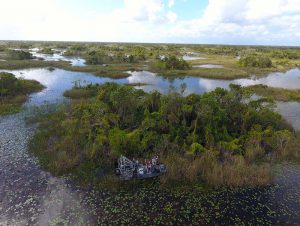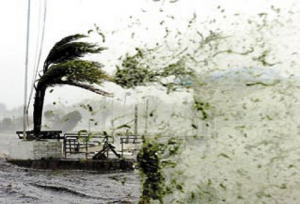Flooded homes, torn-off roofs, and downed powerlines – these are usually the first images that spring to mind when talking about hurricanes. While it is true hurricanes can be a major force of destruction for people, they can also have a big impact on our ecosystems.
Some of these impacts are obvious; like the wind knocking down trees or storm surge flooding areas with saltwater. What is less clear is the effect of hurricanes on invasive plants. Invasive plants are non-native species that aggressively spread into natural areas and cause environmental and/or economic harm. On one hand, hurricanes might increase populations of some invasive plants by spreading their seeds through wind and flooding. However, hurricanes also create harsh conditions some invasive plants cannot survive.
So overall, are hurricanes good or bad for invasive plants? Ultimately, it depends on the specific habitat and invasive species you are considering.
Here is how hurricanes can affect invasive plants in some of our ecosystems:
Forests and Tree Islands

Hurricanes are notorious for knocking down trees in forests and tree islands. Tree islands are dry, forested, patches of ground in wetlands like the Everglades. This creates open spaces rich in light, space and nutrients, making them prime real estate for plants. Many invasive plants are able to colonize these open areas and grow back more quickly than native plants. Old world climbing fern (Lygodium microphyllum) is an example of an invasive plant known to have caused this problem in south Florida. In 2007, researchers with the University of Florida (UF) and U.S. Fish and Wildlife Service studied the spread of old world climbing fern on tree islands after three major hurricanes in 2004 and 20051. They found old world climbing fern growing in 76% of plots where trees were knocked down by the hurricanes, compared to only 15% of plots where no trees had fallen.
Coastal Wetlands

Plant communities in coastal areas can be destroyed by hurricane-force winds, and storm surge can flood coastal wetlands with ocean water. The increase in salinity can kill plants not tolerant of salt, while giving salt tolerant species a competitive advantage. For example, the invasive grass common reed (Phragmites australis) can survive in areas flooded with saltwater, and a 2014 study2 by researchers at Louisiana State University found this allowed it to spread further in coastal wetlands after hurricanes.
Lakes

When it comes to the shallow lakes, which are common throughout Florida, hurricanes can reduce populations of submersed invasive plants such as hydrilla (Hydrilla verticillata). Strong wind, waves, and currents can physically rip hydrilla out of the sediment. In addition, hurricanes can affect water quality in lakes. Researchers with UF found increases in total phosphorus, total nitrogen, water color, and chlorophyll in south Florida lakes after the 2004 hurricane season3. Another study by researchers with the South Florida Water Management District found Hurricane Irene increased turbidity and nutrients in Lake Okeechobee4. These conditions lower the amount of sunlight reaching through the water, which can suppress growth of submersed aquatic plants like hydrilla.
Sources:
1 Lynch RL, Chen H, Brandt LA, and Mazzottii FJ (2009) Old world climbing fern (Lygodium microphyllum) invasion in hurricane caused treefalls. Natural Areas Journal 29:210-215 https://doi.org/10.3375/043.029.0302
2 Bhattarai GP, Cronin JT (2014) Hurricane activity and the large-scale pattern of spread of an invasive plant species. PLoS ONE 9:e98478 https://doi.org/10.1371/journal.pone.0098478
3 Hoyer MV, Backmann RW, Canfield Jr. DE (2008) Lake management (muck removal) and hurricane impacts to the trophic state of Lake Tohopekaliga, Florida. Lake and Reservoir Management 24:57-68 https://doi.org/10.1080/07438140809354051
4 Havens KE, Jin K, Rodusky AJ, Sharfstein B, Brady MA, East TL, Iricanin R, James T, Harwell MC, Steinman AD (2001) Hurricane effects on a shallow lake ecosystem and its response to a controlled manipulation of water level. The Scientific World 1:44-70 https://doi.org/10.1100/tsw.2001.14
This blog post was written by Dr. Candice Prince, Assistant Professor with the Agronomy department at the UF/IFAS Center for Aquatic and Invasive Plants. This post features research and information from a current project he is analyzing at the Center. Questions or comments can be sent to the UF/IFAS CAIP communications manager at caip@ifas.ufl.edu. Follow UF/IFAS CAIP on Instagram, Facebook, and Twitter. Subscribe for more blogs like this one.
UF/IFAS Center for Aquatic and Invasive Plants. Turning Science Into Solutions.
Did you find this post helpful? Click the heart below!
 1
1
